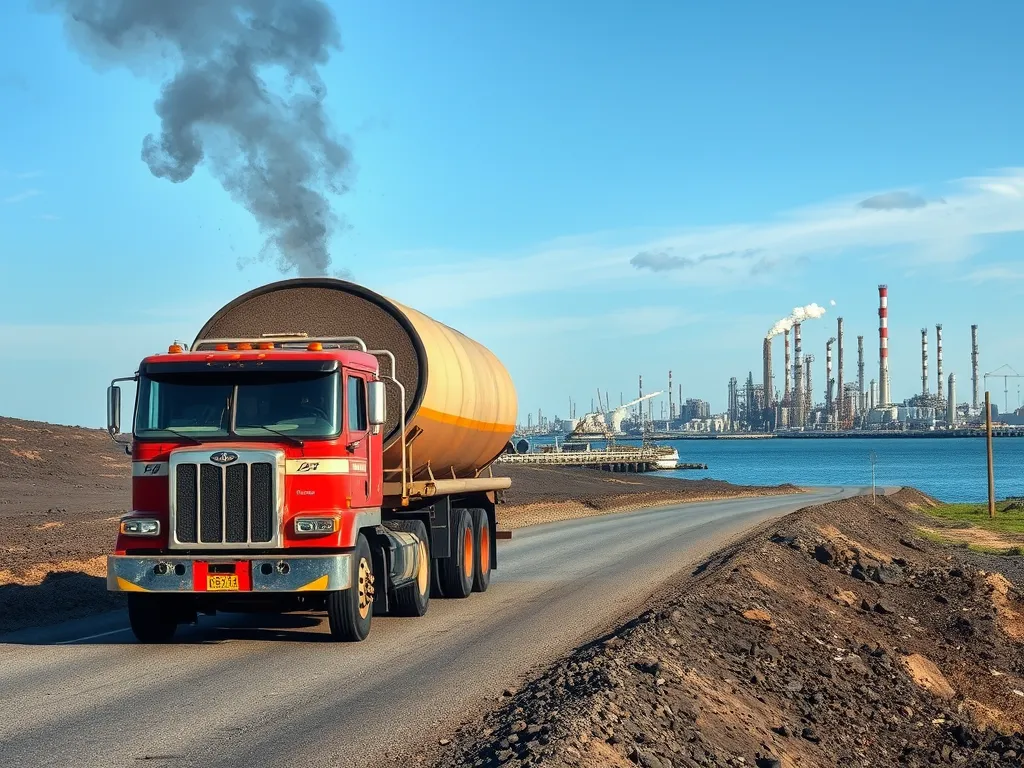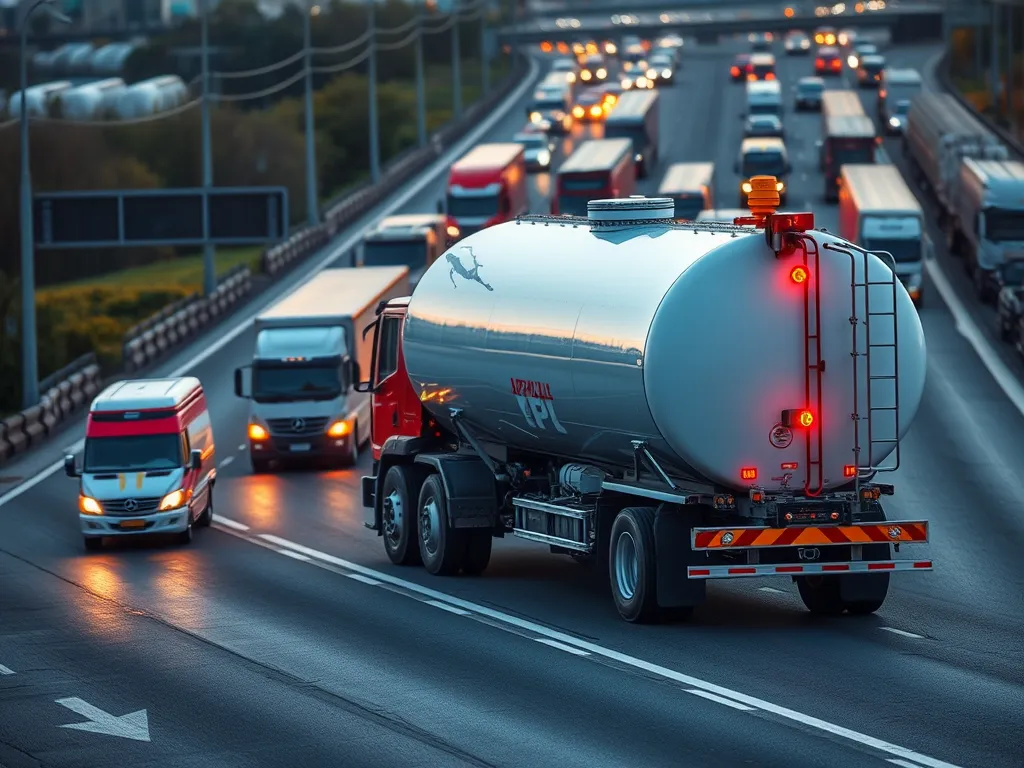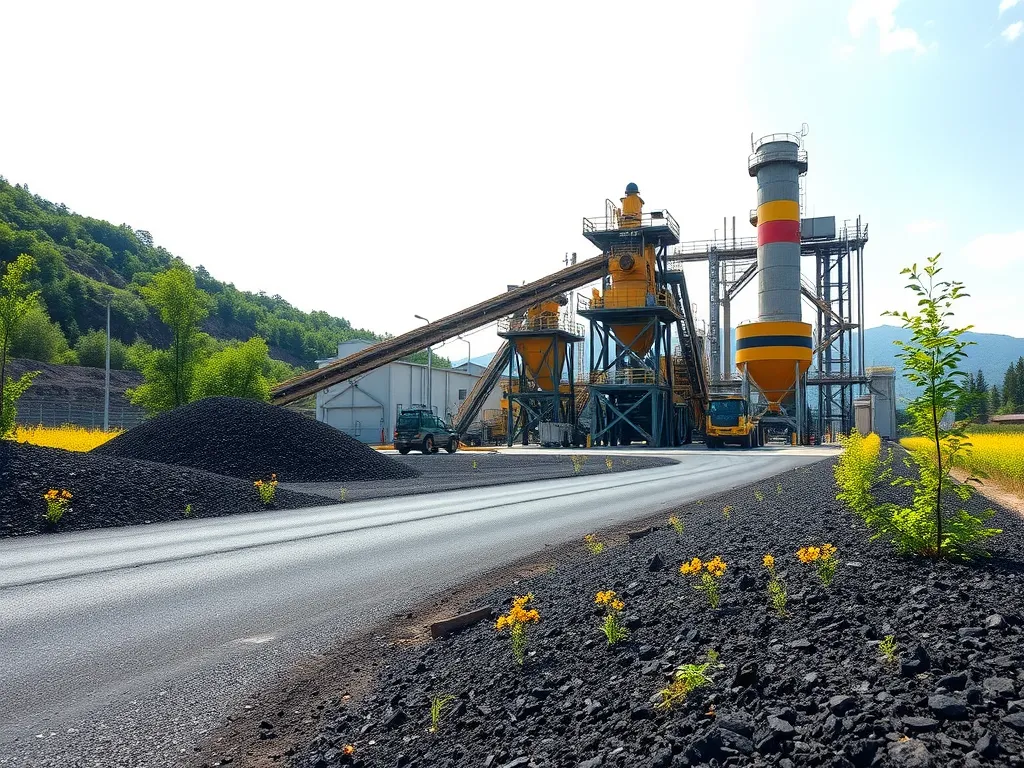Asphalt Supply Chain Dynamics: Components, Challenges, and Optimization
Published on: August 3, 2025 | Last Updated: April 14, 2025
Written By: George Voss
Asphalt supply chain dynamics track how raw materials become finished pavement through interconnected steps. This system moves bitumen (a sticky binder from crude oil), aggregates like gravel, and additives from mines, refineries, and suppliers to construction sites. Unlike typical supply chains, asphalt requires precise temperature control, rapid delivery timelines, and strict quality checks to meet paving specifications. Market shifts, crude oil price swings (which can alter asphalt costs by 30-50% annually), and regional material shortages directly impact availability and project budgets.
This article breaks down the asphalt supply chain’s key parts, roadblocks, and fixes. You’ll see how refineries convert crude oil into asphalt cement, why trucking distances affect pavement costs by $2-$5 per ton, and how GPS tracking cuts delays. We’ll cover strategies like using warm mix asphalt (WMA) to extend hauling windows and recycled asphalt pavement (RAP) to cut virgin material needs by 20-30%. Environmental rules, labor gaps, and storage limits also play roles – we map solutions for each.
Contents
- Understanding the Asphalt Supply Chain Process
- Key Factors Influencing Asphalt Supply Chain Dynamics
- Challenges in Asphalt Logistics and Transportation
- Strategies for Asphalt Supply Chain Optimization
- Environmental Considerations in Asphalt Supply Chains
- FAQs: Asphalt Supply Chain Dynamics
- Closing Thoughts
- Additional Resources for You:
Understanding the Asphalt Supply Chain Process
The asphalt supply chain spans from oil wells to highways. Each step demands precise coordination to keep roads built and maintained. Let’s break down how materials move through this system.
Core Components Of Asphalt Material Supply Chains
Five critical stages define the asphalt material supply chain. Missing one disrupts pavement projects from Texas to Maine.
Raw Material Acquisition (Crude Oil and Bitumen)
Bitumen starts as crude oil extracted from reserves in regions like Canada’s oil sands or U.S. shale basins. Refineries process 20-30 barrels of crude to yield 1 ton of asphalt binder. Geopolitical shifts and drilling permits directly affect bitumen availability and pricing.
Asphalt Production and Refining Processes
Refineries use vacuum distillation to separate bitumen from lighter fuels. Mix plants then combine 5% binder with 95% aggregates (crushed stone, sand). Advanced facilities add polymers or fibers for high-traffic mixes. Production temps hit 300-350°F to maintain workability.
Storage and Distribution Logistics
Hot storage tanks hold asphalt at 275-325°F to prevent hardening. Regional terminals stockpile mixes for 2-4 weeks during peak seasons. Insulated tanker trailers move materials within a 150-mile radius to balance heat loss and delivery speed.
Transportation to Construction Sites
Trucks haul 96% of asphalt in the U.S., with costs ranging $1.50-$3.00 per ton-mile. Rail and barges handle longer hauls but require reheating at terminals. Delays over 90 minutes risk mix cooling below 250°F, triggering $200+/ton rejection fees.
Application in Road Construction and Maintenance
Pavers lay mixes at 250°F minimum for proper compaction. Supply chain hiccups here cause visible defects like raveling or cracks. Just-in-time delivery slashes idle time for $15,000/day paving crews.
Grasping these components sets the stage to explore factors shaping the asphalt industry supply chain. Next, we’ll examine how oil prices, regulations, and labor shortages impact operations.
Key Factors Influencing Asphalt Supply Chain Dynamics
Global asphalt supply chains face constant shifts from market forces, policy shifts, and physical limits. Five factors shape material flow from refineries to road sites.
Crude Oil Price Volatility and Refining Margins
Bitumen costs swing with crude oil markets. A $10/barrel shift alters asphalt prices by $12-$18 per ton. Refiners prioritize diesel or jet fuel when margins dip, cutting bitumen output. Supply gaps form fast—U.S. asphalt production dropped 7% in 2022 as refiners shifted to high-margin fuels.
Demand Fluctuations in Road Construction Markets
Federal funding drives 63% of U.S. asphalt consumption. Delays in bills like the Infrastructure Investment and Jobs Act (IIJA) create boom-bust cycles. States stockpile 300-400 tons per mile during peak seasons. Weather halts 45% of paving in northern states from November-March, straining storage.
Regulatory Impacts on Asphalt Manufacturing
New EPA rules require plants to cut CO2 by 22% by 2026. Upgrading pollution controls adds $4.2M per facility. California’s AB 423 mandates 15% RAP in mixes, forcing plants to retrofit silos and feeders. PG binder specs now need 18-hour lab tests per batch, slowing output.
Labor Shortages in Transportation and Production
15% of CDL trucking jobs sit unfilled—critical for moving 290°F asphalt. Plants report 23% fewer skilled operators since 2020. Training programs take 14 months but retain only 61% of hires. Night shifts at Texas plants now pay $38/hour to keep crews.
Geographic Constraints in Material Availability
Bitumen travels 1,200 miles on average from Gulf Coast refineries to Midwest job sites. Permian Basin aggregates cost 40% more in New England. Coastal states import 18% of binders via Panamax tankers. Stockpiling RAP cuts haul distances by 65% in material-scarce zones.
These factors set the stage for logistics hurdles. Moving hot-mix asphalt demands precision timing and gear—challenges we’ll unpack next.

Challenges in Asphalt Logistics and Transportation
Moving asphalt from refineries to job sites tests every link in the supply chain. Temperature demands, delivery deadlines, and seasonal rushes create hurdles requiring precise coordination across production, storage, and transport networks.
Managing Temperature Control During Hauling
Asphalt must stay between 275°F and 325°F during transit. Drop below 250°F, and the material hardens, becoming unusable. Insulated tankers with double-walled steel maintain heat for 48-72 hours. Some fleets add warm mix additives like Evotherm® or Sasobit® to lower required temps by 50°F, extending haul ranges up to 25% farther.
Intermodal Transportation Complexities
Switching between trucks, railcars, and barges introduces risks. Rail delays account for 34% of asphalt delivery bottlenecks. Each transfer requires reheating equipment to prevent thermal loss. Port congestion adds 12-48 hours to coastal shipments. Strategic placement of regional terminals reduces reliance on cross-country routes vulnerable to weather or equipment breakdowns.
Timeliness Of Delivery for Paving Projects
Paving crews need fresh asphalt within 30 minutes of trucks arriving. Late deliveries force crews to rework schedules at $1,200-$2,500 per hour in lost productivity. GPS tracking paired with traffic algorithms cuts late arrivals by 18%. Contracts now include liquidated damages clauses charging suppliers $150-$400 per hour for missed windows.
Seasonal Demand Peaks and Storage Limitations
Over 80% of asphalt gets placed between May and October. Storage tanks hold 3-5 days’ supply at most. During peak months, plants run 24/7 but still face shortages. Recycled asphalt pavement (RAP) stockpiles help bridge gaps but require separate handling to prevent contamination. Cold winter months see 60% of storage capacity sit empty while maintenance backlogs grow.
Tackling these logistical hurdles paves the way for exploring optimization strategies that boost efficiency across the asphalt supply chain.
Also See: Cold Mix Asphalt Formulation Variations for Cost Savings
Strategies for Asphalt Supply Chain Optimization
Modern asphalt supply chains require smart tactics to balance cost, speed, and quality. Four proven methods are reshaping how materials move from refineries to job sites.
Leveraging Data-driven Demand Forecasting
Predictive analytics tools crunch numbers from past projects, weather trends, and infrastructure budgets. Machine learning models spot patterns in asphalt consumption across regions. Texas-based Baker Corp cut surplus inventory by 18% using AI-powered forecasts tied to highway department schedules. These systems help plants adjust production before demand spikes hit.
Adopting Warm Mix Asphalt Technologies
Warm mix asphalt (WMA) slashes production temps from 300-350°F to 250-275°F. Lower heat means:
| Factor | Traditional HMA | WMA |
|---|---|---|
| Fuel Use | 100% | 20-25% less |
| Haul Window | 1 hour | 2+ hours |
Extended haul times let trucks reach distant sites without losing material workability. Over 40% of U.S. paving projects now use WMA for its supply chain flexibility.
Enhancing Supplier Collaboration and Contracts
Strong partnerships with bitumen suppliers prevent material shortages. Multi-year contracts with price adjustment clauses shield against crude oil swings. Vulcan Materials uses shared planning portals with 200+ suppliers to sync asphalt deliveries with plant schedules. Teams resolve bottlenecks faster through joint problem-solving sessions.
Implementing Real-time Tracking Systems
GPS-enabled tankers with temperature sensors send alerts if asphalt drops below 275°F during transit. Missouri DOT reduced rejected loads by 22% using live tracking dashboards. Drivers reroute around traffic jams while plants monitor truck locations to prioritize urgent orders.
These tactics set the stage for tackling environmental pressures in asphalt networks. Next, we’ll examine how sustainability goals are reshaping material sourcing and emissions control.

Environmental Considerations in Asphalt Supply Chains
Balancing production demands with ecological responsibility reshapes how asphalt supply chains operate. From recycled material use to cleaner transport methods, green practices now drive key decisions across material sourcing, manufacturing, and delivery phases.
Recycled Asphalt Pavement (RAP) Integration Challenges
Over 90 million tons of RAP enter U.S. asphalt supply chains yearly, but reuse faces hurdles. State DOTs limit RAP percentages (typically 15-30%) due to stiffness variations in aged binder. Processing costs rise when sorting mixed demolition debris or removing contaminants like concrete chunks. Plants upgrading to handle higher RAP volumes spend $250k+ on specialized heaters and grinders to maintain mix quality.
Emissions Reduction in Production and Transportation
Warm Mix Asphalt (WMA) technologies cut plant temps by 50°F, slashing CO2 output 15-30% per ton. Hybrid drum plants with reclaimed heat systems lower fuel use 18-22%. For transport, GPS-optimized truck routes trim diesel consumption 12% on average. California mandates Tier 4 engines for haulers, reducing particulate emissions 90% versus older fleets.
Sustainable Sourcing Of Raw Materials
Bitumen suppliers now track crude origins, favoring Alberta oil sands mines with land reclamation plans. Aggregate mines within 50 miles of plants lower transport emissions 8-10 tons per load. Bio-binders from pine resin or algae enter trials, aiming to replace 5-7% of petroleum-based bitumen by 2025. Third-party certifications like GreenCircle validate recycled content claims for LEED projects.
These eco-strategies set the stage for tighter regulations. Next, we’ll explore how evolving policies shape asphalt supply chain management practices.
FAQs: Asphalt Supply Chain Dynamics
How Do Crude Oil Prices Directly Impact Asphalt Costs?
Crude oil prices are a major determinant of asphalt costs. A fluctuation in crude oil can significantly affect the prices of asphalt, as it is derived from the refining of crude oil. For instance, a $10 increase in crude oil prices can lead to an increase of approximately $12-$18 per ton of asphalt, creating a ripple effect on budgeting and project costs.
What Role Does Refinery Capacity Play in Supply Stability?
Refinery capacity is crucial for maintaining a stable supply of asphalt. When refining margins are low, refineries may prioritize the production of higher-margin fuels, leading to a decrease in asphalt output. This shift can create supply gaps, especially during peak construction periods, ultimately affecting project timelines and costs.
Why is Temperature Management Critical During Transportation?
Temperature management is essential because asphalt must be transported at specific temperatures (between 275°F and 325°F) to maintain its workability. If temperature drops below 250°F during transit, the asphalt can harden, making it unusable without significant reheating. Insulated trailers and warm mix technologies are deployed to ensure that asphalt remains at appropriate temperatures throughout transportation.
What Are the Consequences Of Labor Shortages in the Asphalt Supply Chain?
Labor shortages, particularly in skilled positions such as truck drivers and production operators, can lead to significant delays in asphalt delivery and production. With unfilled positions, there are bottlenecks in transportation and asphalt processing, which can cause project delays and inflate project costs due to increased overtime and potentially missed deadlines.
How Does Geographic Location Affect Asphalt Availability?
Geographic location impacts the availability and cost of asphalt significantly. Regions far from refineries often face higher material costs due to increased transportation distances. For example, sourcing bitumen from the Gulf Coast to the Midwest adds logistical complexities and costs, leading to variations in pricing and availability depending on the local infrastructure and material sources.
What Strategies Are Used to Address Seasonal Demand Peaks?
To address seasonal demand peaks, companies often utilize strategies such as stockpiling recycled asphalt pavement (RAP) and adjusting production schedules to meet anticipated demand. Many plants increase operating hours or shift to 24/7 operations during peak construction months to maximize output and ensure that they can meet the needs of paving projects without significant delays.
What Are Some Environmental Practices Adopted in Asphalt Supply Chains?
Asphalt supply chains are increasingly adopting environmental practices such as the use of recycled asphalt pavement (RAP) and warm mix asphalt (WMA) technologies. These practices help reduce emissions during production and transportation while also promoting the sustainable sourcing of raw materials. Companies are also increasingly focused on reducing their carbon footprint and improving energy efficiency in their operations.

Closing Thoughts
The dynamics of the asphalt supply chain are complex yet crucial for the construction industry. Understanding each component, from raw material acquisition to the final application, sheds light on the challenges and opportunities that lie within this sector. Factors such as crude oil prices, environmental considerations, and labor shortages play significant roles in shaping the landscape of asphalt production and logistics.
Optimizing the supply chain involves leveraging technology, embracing innovative materials like Warm Mix Asphalt, and fostering collaboration among suppliers. By implementing strategies such as real-time tracking and data-driven forecasting, stakeholders can navigate issues related to delivery timeliness and cost management more effectively.
Sustainability is also a vital aspect of modern asphalt practices. Integrating recycled materials and focusing on emissions reduction can enhance not just efficiency but also environmental outcomes.
For further insights into asphalt supply chains, calculations, and more, visit Asphalt Calculator USA.


